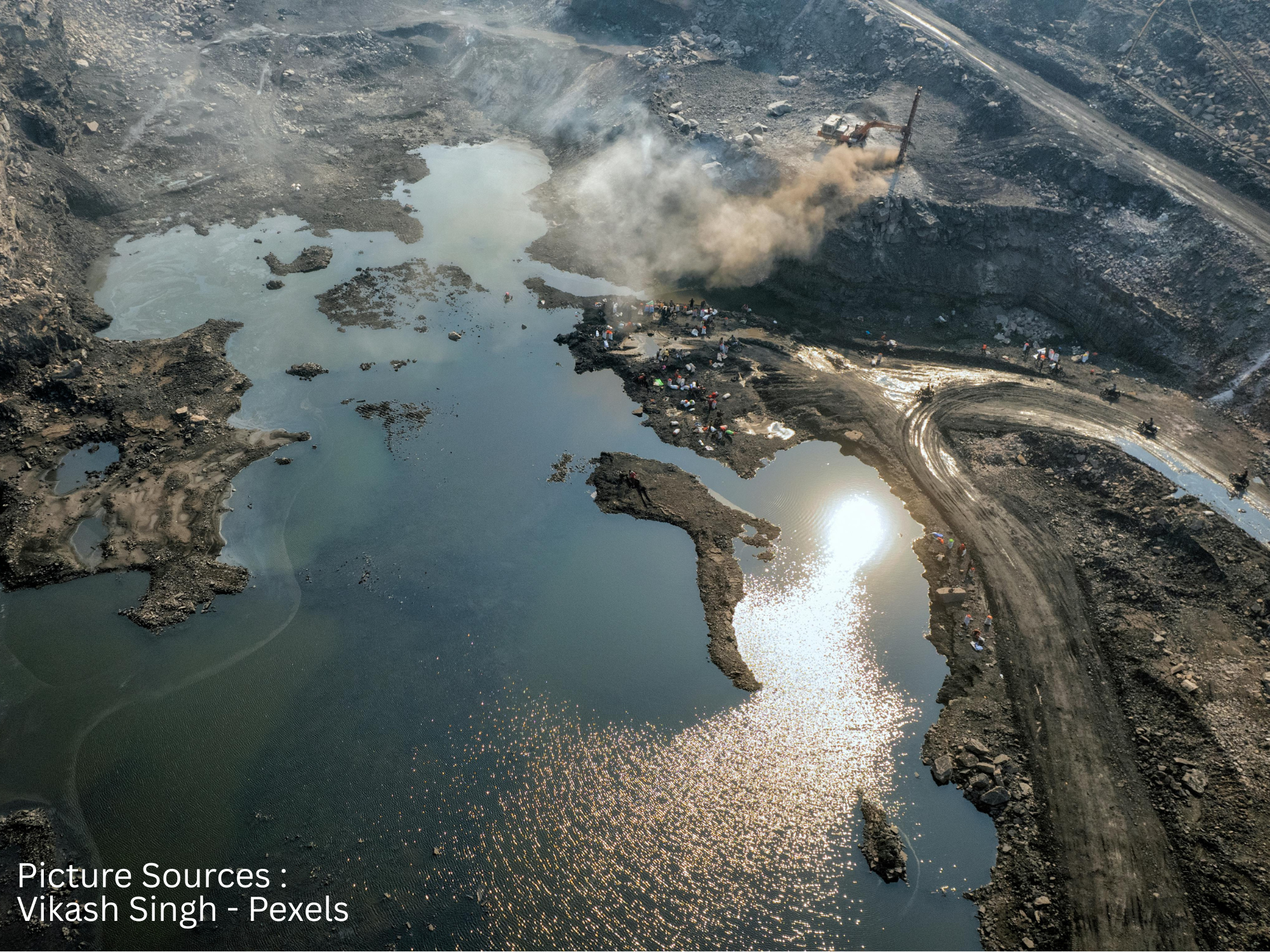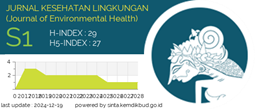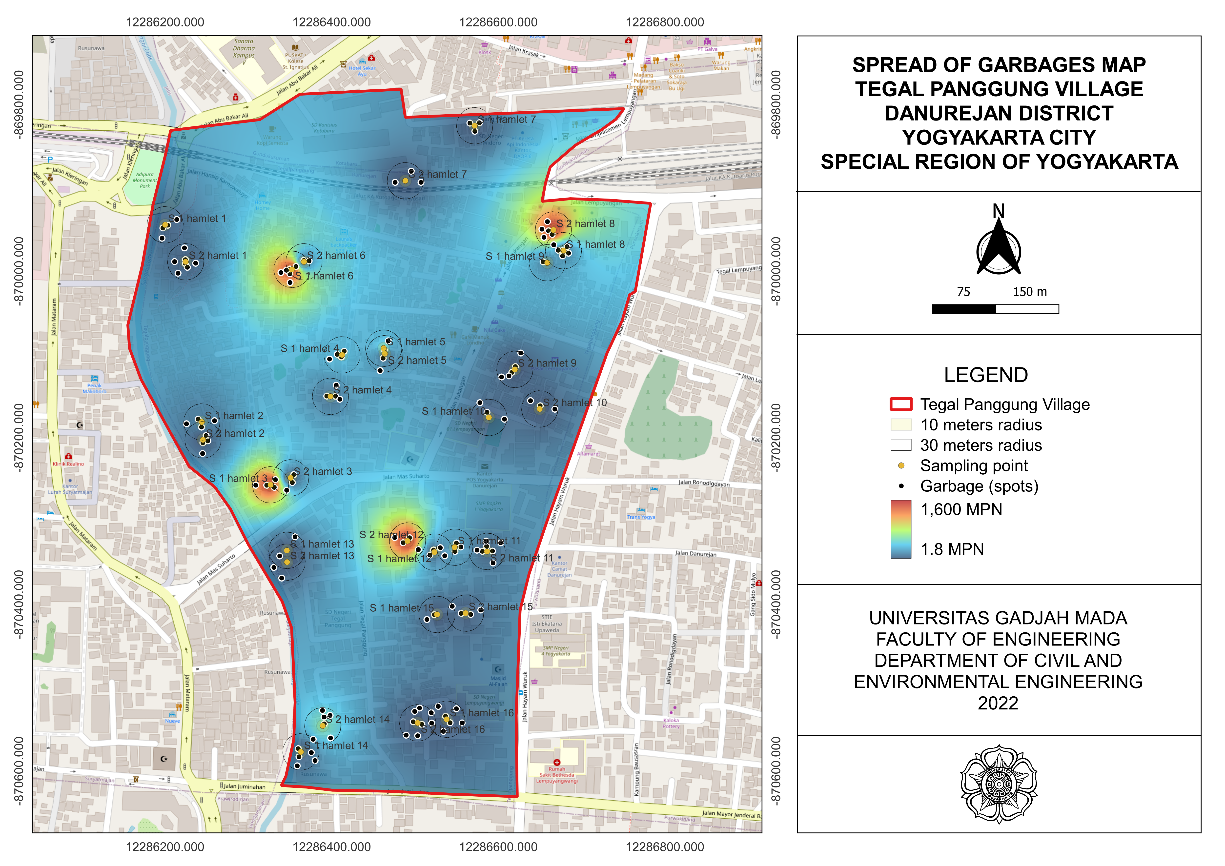Heavy Metals Pollution in Drinking Water Sources: A Case Study from Kulim Hi-Tech Park, Malaysia

Introduction: Heavy metal content within drinking water poses significant risks to health and the environment. Given industrial impact on Kulim’s water quality, this study determined the concentrations of iron (Fe), manganese (Mn), zinc (Zn), cadmium (Cd), and nickel (Ni) in various water sources around Kulim Hi-Tech Park (KHTP) and assess associated with chronic heath risks. Methods: We measured these five heavy metals in 30 water samples from tap water, rivers, and ponds, within and around Kulim Hi-Tech Park (KHTP), using Atomic Absorption Spectroscopy. Non-carcinogenic risk was assessed by calculating Hazard Quotient (HQ) and Hazard Index (HI), while carcinogenic risk used Excess Lifetime Cancer Risk (ELCR). Results and Discussion: Mean concentrations averaged between 0.0177 ± 0.0017 mg/L and 0.8652 ± 0.0606 mg/L; nickel showed the highest mean, followed by iron, zinc, manganese, and cadmium. Notably, concentrations of nickel, and in some instances iron and cadmium, exceeded regulatory limits. HQ and HI suggested no immediate adverse health effects from exposure to iron, manganese, and zinc. However, ELCR values for cadmium and nickel surpassed acceptable levels, indicating potential carcinogenic risks from long-term exposure. It is important to note that risk assessment for iron, manganese, and zinc is based on mean concentrations that include proportion of samples below the Limit of Quantification (LOQ), warranting cautious interpretation. Conclusion: This study provides crucial baseline data on heavy metals in KHTP water resources, underscores more investigation and potential remediation strategies to safeguard public and environmental health.
Mitra S, Chakraborty AJ, Tareq AM, Emran TB, 1. Nainu F, Khusro A, et al. Impact of Heavy Metals on the Environment and Human Health: Novel Therapeutic Insights to Counter the Toxicity. Journal of King Saud University-Science. 2022;34(3):1-21. https://doi.org/10.1016/j.jksus.2022.101865
Nguyen LSP, Hau LQ, Pham TDH, Thuy NT, Hien 2. TT. Concurrent Measurements of Atmospheric Hg in Outdoor and Indoor at a Megacity in Southeast Asia: First Insights from the Region. Atmospheric Pollution Research. 2024;15(12):1-9. https://doi.org/10.1016/j.apr.2024.102326
Zheng K, Zeng Z, Tian Q, Huang J, Zhong Q, 3. Huo, X. Epidemiological Evidence for the Effect of Environmental Heavy Metal Exposure on the Immune System in Children. Science of the Total Environment. 2023;868(161691):1-14. https://doi.org/10.1016/j.scitotenv.2023.161691
WHO. Human Health Effects of Benzene, Arsenic, 4. Cadmium, Nickel, Lead and Mercury: Report of an Expert Consultation. Geneva, Switzerland: WHO; 2024. https://www.who.int/europe/publications/i/item/WHO-EURO-2023-8983-48755-72523
Duan W, Xu C, Liu Q, Xu J, Weng Z, Zhang X, 5. et al. Levels of a Mixture of Heavy Metals in Blood and Urine and All-cause, Cardiovascular Disease and Cancer Mortality: a Population-Based Cohort Study. Environmental Pollution. 2020;263(114630):1-9. https://doi.org/10.1016/j.envpol.2020.114630
Ebrahimi M, Khalili N, Razi S, Keshavarz-Fathi 6. M, Khalili N, Rezaei N. Effects of Lead and Cadmium on the Immune System and Cancer Progression. Journal of Environmental Health Science and Engineering. 2020;18:335-343. https://doi.org/10.1007/s40201-020-00455-2
Jayakumar M, Surendran U, Raja P, Kumar 7. A, Senapathi V. A Review of Heavy Metals Accumulation Pathways, Sources and Management in Soils. Arabian Journal of Geosciences. 2021;14(20):1-19. https://doi.org/10.1007/s12517-021-08543-9
Kharazi A, Leili M, Khazaei M, Alikhani MY, 8. Shokoohi R. Human Health Risk Assessment of Heavy Metals in Agricultural Soil and Food Crops in Hamadan, Iran. Journal of Food Composition and Analysis. 2021;100(103890):1-16. https://doi.org/10.1016/j.jfca.2021.103890
Peng JY, Zhang S, Han Y, Bate B, Ke H, Chen Y. 9. Soil Heavy Metal Pollution of Industrial Legacies in China and Health Risk Assessment. Science of the Total Environment. 2022;816(151632):1-12. https://doi.org/10.1016/j.scitotenv.2021.151632
`10. Adimalla N. Heavy Metals Pollution Assessment 10. and Its Associated Human Health Risk Evaluation of Urban Soils from Indian Cities: A Review. Environmental Geochemistry and Health. 2020;42(1):173-190. https://doi.org/10.1007/s10653-019-00324-4
Sarihi S, Niknam M, Mahjour S, Hosseini-Bensenjan 11. M, Moazzen F, Soltanabadi S, et al. Toxic Heavy Metal Concentrations in Multiple Sclerosis Patients: A Systematic Review and Meta-Analysis. EXCLI journal. 2021;20:1571-1584. 10.17179/excli2021-3484
Bakulski KM, Seo YA, Hickman RC, Brandt D, Vadari 12. HS, Hu H. Heavy Metals Exposure and Alzheimer’s Disease and Related Dementias. Journal of Alzheimer’s Disease. 2020;76(4):1215-1242. https://doi.org/10.3233/JAD-200282
Parida L, Patel TN. Systemic Impact of Heavy 13. Metals and Their Role in Cancer Development: A Review. Environmental Monitoring and Assessment. 2023;195(6):1-27. https://doi.org/10.1007/s10661-023-11399-z
Zhou Q, Yang N, Li Y, Ren B, Ding X, Bian H, et 14. al. Total Concentrations and Sources of Heavy Metal Pollution in Global River and Lake Water Bodies from 1972 to 2017. Global Ecology and Conservation. 2020;22(e00925):1-11. https://doi.org/10.1016/j.gecco.2020.e00925
Kulim Technology Park Corporation Sdn Bhd. Kulim 15. Hi-Tech Park - Leading Global Science City. Kulim: KHTP Corporation SB; 2025 https://www.khtp.com.my/
Das S, Sultana KW, Ndhlala AR, Mondal M 16. and Chandra I. Heavy Metal Pollution in the Environment and its Impact on Health: Exploring Green Technology for Remediation. Environmental Health Insights. 2023; 17(1259):1-10. https://doi.org/10.1177/11786302231201259
Wu H, Wang X, Ren H, Gao M, Cai J, Cheng J. 17. Groundwater Heavy Metal Pollution Characteristicsand Health Risk Assessment in Typical Industrial Parks in Southwest China. Water. 2024;16(23):1-23. https://doi.org/10.3390/w16233435
Jagaba, A.H., Lawal, I.M., Birniwa, A.H., Affam, 18. A.C., Usman, A.K., Soja, et al. Sources of Water Contamination by Heavy Metals. Membrane Technologies for Heavy Metal Removal from Water 2024;17(4):3-27. https://doi.org/10.1201/9781003326281-2
Moretti A, Ivan HL, Skvaril J. A Review of the State-19. of-the-Art Wastewater Quality Characterization and Measurement Technologies. Is the Shift to Real-time Monitoring Nowadays Feasible? Journal of Water Process Engineering. 2024; 60(105061):1-19. https://doi.org/10.1016/j.jwpe.2024.105061
Noventa S, Pace E, Esposito D, Libralato G, Manfra 20. L. Handling Concentration Data Below the Analytical Limit in Environmental Mixture Risk Assessment: A Case-Study on Pesticide River Monitoring. Science of the Total Environment. 2024;907(167670):1-14. https://doi.org/10.1016/j.scitotenv.2023.167670
Agency for Toxic Substances and Disease Registry21. . Exposure Dose Guidance for Body Weight. Atlanta, Georgia: United States Department of Health and Human Services, Public Health Service; 2023. https://www.atsdr.cdc.gov/pha-guidance/resources/ATSDR-EDG-Body-Weight-508.pdf
Rajkowska-Myśliwiec M, Ciemniak A, Karp G. 22. Arsenic in Rice and Rice-Based Products with Regard to Consumer Health. Foods. 2024;13(19):1-21. https://doi.org/10.3390/foods13193153
Zakir HM, Sharmin S, Akter A, Rahman MS. 23. Assessment of Health Risk of Heavy Metals and Water Quality Indices for Irrigation and Drinking Suitability of Waters: A Case Study of Jamalpur Sadar Area, Bangladesh. Environmental Advances. 2020;2(100005):1-14. https://doi.org/10.1016/j.envadv.2020.100005
Siqueira, TD, Pessoa LA, Vieira L, Cionek VM, 24. Singh SK, Benedito E. Evaluating Land Use Impacts on Water Quality: Perspectives for Watershed Management. Sustainable Water Resources Management. 2023;9(6):1-24. https://doi.org/10.1007/s40899-023-00968-2
Liu D, Yu H, Feng H, Gao H, Zhu Y. Revealing Heavy 25. Metal Correlations with Water Quality and Tracking its Latent Factors by Canonical Correlation Analysis and Structural Equation Modeling in Dongjianghu Lake. Environmental Monitoring and Assessment. 2021;193(717):1-14. https://doi.org/10.1007/s10661-021-09516-x
Zairullah A, Hamzani S. Iron Contamination in Dug 26. Well Water and its Impact on Household Use in an Urban Indonesian Residential Area. Global Health & Environmental Perspectives. 2025;2(1):187-196. https://doi.org/10.61848/ghep.v2i1.127
Boutebib AB, N’diaye AD, M’Baye BK, Ali YAEH, 27. Hammouti B, Semega BM. Assessment of Iron Contamination in Groundwater of Catchment Area Water. Indonesian Journal of Science and Technology. 2023;8(3):429-438. https://doi.org/10.17509/ijost.v8i3.60560
Chowdhury TN, Hasan MM, Munna GM, Alam MJB, 28. Nury AH, Islam S. Hazard-Mapping and Health Risk Analysis of Iron and Arsenic Contamination in the Groundwater of Sylhet District. Journal of Water and Health. 2024;22(4):757-772. https://doi.org/10.2166/wh.2024.018
Ruzi II, Ishak AR, Abdullah MA, Zain NNM, Tualeka 29. AR, Adriyani R. Heavy Metal Contamination in Sungai Petani, Malaysia: A Wastewater-based Epidemiology Study. Journal of Water and Health. 2024;22(6):953–66. https://doi.org/10.2166/wh.2024.241
Kontoghiorghes GJ. Iron Load Toxicity in 30. Medicine: From Molecular and Cellular Aspects to Clinical Implications. International Journal of Molecular Sciences. 2023;24(16):1-28. https://doi.org/10.3390/ijms241612928
Corradini E, Buzzetti E, Pietrangelo A. Genetic Iron 31. Overload Disorders. Molecular Aspects of Medicine. 2020;75(100896):1-10. https://doi.org/10.1016/j.mam.2020.100896
Obeng SK, Kulhánek M, Balík J, Černý J, Sedlář 32. O. Manganese: From Soil to Human Health—A Comprehensive Overview of its Biological and Environmental Significance. Nutrients. 2024;16(20):1-18. https://doi.org/10.3390/nu16203455
Magro G, Laterza V, Tosto F, Torrente A. Manganese 33. Neurotoxicity: A Comprehensive Review of Pathophysiology and Inherited and Acquired Disorders. Journal of Xenobiotics. 2025;15(2):1-18. https://doi.org/10.3390/jox15020054
Zhou J, Jiang Z, Qin X, Zhang L. Heavy Metal 34. Distribution and Health Risk Assessment in Groundwater and Surface Water of Karst Lead–Zinc Mine. Water. 2024;16(15):2179-2189. https://doi.org/10.1016/j.envadv.2020.100005
Hussain S, Khan M, Sheikh TMM, Mumtaz 35. MZ, Chohan TA, Shamim S. Zinc Essentiality, Toxicity, and its Bacterial Bioremediation: A Comprehensive Insight. Frontiers in Microbiology. 2022;13(900740):1-15. https://doi.org/10.3389/fmicb.2022.900740
Ding Z, Han G, Qu R, Liu J, Wang P. Review on 36. Zinc Isotopes in River Systems: Distribution and Application. Water. 2024;16(1):1-16. https://doi.org/10.3390/w16010087
Sabet AP, Cheraghi M, Lorestani B, Sobhanardakani 37. S, Merrikhpour H. Spatial Distribution of Cadmium in Agricultural Soils of Eghlid County, South of Iran. Archives of Hygiene Sciences. 2020;9(4):311-324. https://doi.org/10.52547/ArchHygSci.9.4.311
Genchi G, Sinicropi MS, Lauria G, Carocci A, Catalano 38. A. The Effects of Cadmium Toxicity. International Journal of Environmental Research and Public Health. 2020;17(11):1-24. https://doi.org/10.3390/ijerph17113782
Yang Y, Hassan MF, Ali W, Zou H, Liu Z, Ma Y. 39. Effects of Cadmium Pollution on Human Health: A Narrative Review. Atmosphere. 2025;16(2):1-23. https://doi.org/10.3390/atmos16020225
Jehan S, Khattak SA, Muhammad S, Ali L, Rashid 40. A, Hussain ML. Human Health Risks by Potentially Toxic Metals in Drinking Water Along the Hattar Industrial Estate, Pakistan. Environmental Science and Pollution Research. 2020;27(3):2677–2690. https://doi.org/10.1007/s11356-019-07219-y
Genchi G, Carocci A, Lauria G, Sinicropi MS, 41. Catalano A. Nickel: Human Health and Environmental Toxicology. International Journal of Environmental Research and Public Health. 2020;17(3):1-21. https://doi.org/10.3390/ijerph17030679
Schuijers L. Responding to Ecological Uncertainty 42. in the Context of Climate Change: Thirty Years of the Precautionary Principle in Australia. Sydney Law Review. 2023;45(2):249-276. https://doi.org/10.5376/aps.2023.45.0010

This work is licensed under a Creative Commons Attribution-NonCommercial-ShareAlike 4.0 International License.
1. Copyright of all journal manuscripts is held by the Jurnal Kesehatan Lingkungan.2. Formal legal provisions to access digital articles of electronic journal are subject to the provision of the Creative Commons Attribution-ShareAlike license (CC BY-NC-SA), which means that Jurnal Kesehatan Lingkungan is rightful to keep, transfer media/format, manage in the form of databases, maintain, and publish articles.
3. Published manuscripts both printed and electronic are open access for educational, research, and library purposes. Additionally, the editorial board is not responsible for any violations of copyright law.
JKESLING by UNAIR is licensed under a Creative Commons Attribution-ShareAlike 4.0 International License.







































